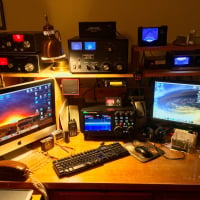Welcome to the FlexRadio Community! Please review the new Community Rules and other important new Community information on the Message Board.
Need the latest SmartSDR or 4O3A Genius Product Software?
SmartSDR v4.1.3 | SmartSDR v4.1.3 Release Notes
SmartSDR v3.10.15 | SmartSDR v3.10.15 Release Notes
The latest 4O3A Genius Product Software and Firmware
SmartSDR v4.1.3 | SmartSDR v4.1.3 Release Notes
SmartSDR v3.10.15 | SmartSDR v3.10.15 Release Notes
The latest 4O3A Genius Product Software and Firmware
If you are having a problem, please refer to the product documentation or check the Help Center for known solutions.
Need technical support from FlexRadio? It's as simple as Creating a HelpDesk ticket.
Need technical support from FlexRadio? It's as simple as Creating a HelpDesk ticket.
9 days since Delivery... observations 6400M How sweet it is.

Stephen Hawkins NG0G
Member ✭✭
Amazing radio. I am hearing and working stuff I would not have heard before. When calling a DX station operating split, listening up1 or 2 with a huge pileup, DX left ear, pileup right ear. Unlike my old radio my left ear is completely unaware of the pileup. No clicking, no thumping. How sweet it is. And Profiles are your friend.
2
Comments
-
Hi Stephen,
For those dx pileups with splits here is how I tackle them and I could not imagine using a non SDR for this:
I expand the pan way out so my full monitor is showing the dx and all of the split pile up signals. When expanded like this you can watch the dx transmit then you can see who answers. You will see their signal.
I use two slices. Slice A is on the receive of the DX. Slice B is TX and is muted.
I watch a couple of QSOs and generally I will see that the DX is tuning either up or down. So then I wait for the next QSO and watch the answer, I think click slice B to be a little above the pile up responder.
I then send my call on the next split. Sometimes it take a couple tries but this technique seems to work quite well. Several times now I've gotten a call right back and I have only a 280 foot loop and an amp.0 -
Years of following the DX around in pileups without an SDR or band scope burned an assembly language subroutine in the neurons between my hand and my right ear. That is one of the many reasons I wanted a radio with knobs. 8-) Also just looking at the band scope can fool you as there are those in the pileups who never stop calling, or call anyway despite who the DX station is coming back to. The only way for me to tell who is who is with my ear.0
-
If you're a CW op, now try it with CW Skimmer and Slice Master! It only gets better.0
-
These look like Windows programs? Are they?0
-
Yes, they run in Windows OS.
Dave wo2x
0 -
Posted this in another thread but it’s worth shouting from the treetops. The other night 20 Meters was completely dead. So much so, that I checked my antenna switch to be safe. I was just about to switch to 40 when a very faint signal trail appeared in the Panadapter. With a quick touch I was on it. I bumped my preamp to half way, then I copied her easy as pie. It was “Mee” from Japan broadcasting with 200watts. We QSOd for about 15 minutes until she ran out of English things to say, so we said good night and I couldn’t stop smiling. The band was still dead as a doornail and I listened to her QRZ and CQs with no other answers. That clinched it for me! Love my 6400M!!1
Leave a Comment
Categories
- All Categories
- 376 Community Topics
- 2.1K New Ideas
- 630 The Flea Market
- 8.2K Software
- 106 SmartSDR+
- 6.4K SmartSDR for Windows
- 183 SmartSDR for Maestro and M models
- 427 SmartSDR for Mac
- 271 SmartSDR for iOS
- 255 SmartSDR CAT
- 190 DAX
- 381 SmartSDR API
- 9.3K Radios and Accessories
- 36 Aurora
- 250 FLEX-8000 Signature Series
- 7.2K FLEX-6000 Signature Series
- 941 Maestro
- 55 FlexControl
- 865 FLEX Series (Legacy) Radios
- 917 Genius Products
- 460 Power Genius XL Amplifier
- 334 Tuner Genius XL
- 123 Antenna Genius
- 295 Shack Infrastructure
- 207 Networking
- 454 Remote Operation (SmartLink)
- 144 Contesting
- 784 Peripherals & Station Integration
- 139 Amateur Radio Interests
- 1K Third-Party Software

